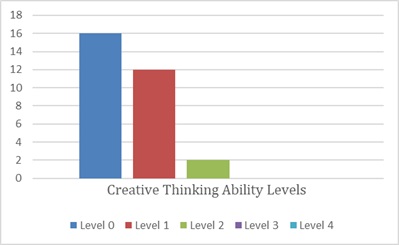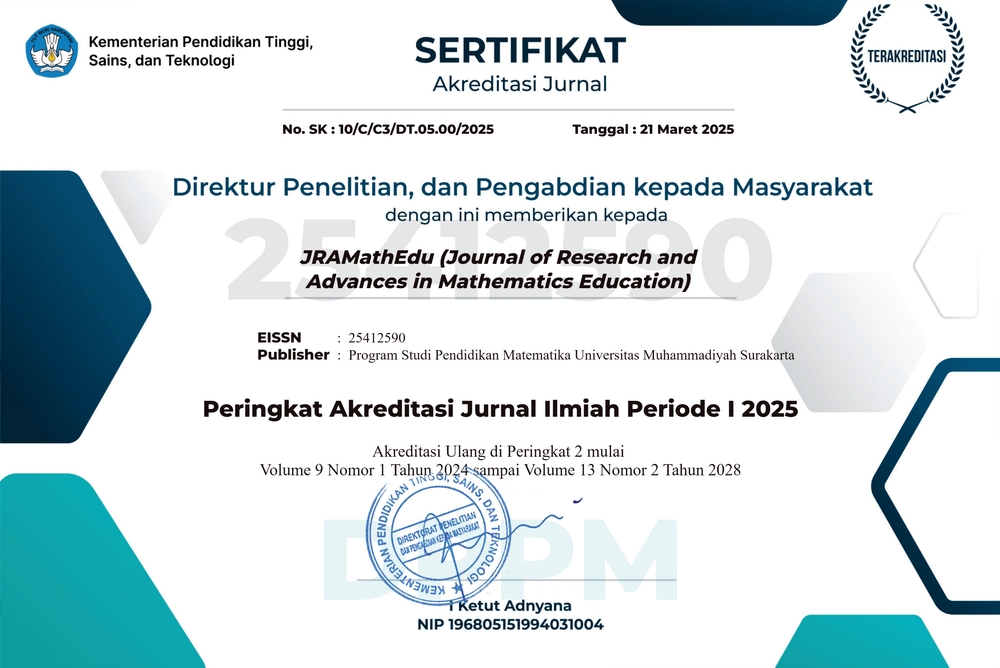Level of creative thinking ability of students in solving numeracy problems
DOI:
https://doi.org/10.23917/jramathedu.v9i2.10453Keywords:
Creative thinking, Mathematics, NumeracyAbstract
Creative thinking plays an important role in the development of new ideas in mathematical solutions that are positively correlated with crucial 21st century skills. This study aims to determine the level of students' creative thinking skills in solving numeracy problems. The research subjects consisted of 30 fourth grade elementary school students in Central Bangka Regency, Bangka Belitung Islands Province. The research method used descriptive research with a qualitative approach. The data collection technique used a written test of 5 questions. The questions were based on the Minimum Competency Assessment (AKM) numeracy test from the Education Assessment Center (Pusmendik). The data test test were analyzed descriptively on the level of creative thinking ability. The results showed that 7% of students reached level 2 in creative thinking, able to solve with original solutions but did not reach fluency or flexibility. Most students reached level 0 and 1 respectively 53% and 40%, the solution did not meet the originality (novelty), fluency, and or flexibility. The low level of creative thinking of elementary school students illustrates that the learning process tends not to be on a new and flexible problem solving process, it is recommended to implement a learning model based on open problem solving or project-based learning that stimulates creative thinking skills.
References
Adiansha, A. A., Khatimah, H., & Asriyadin, A. (2020). Pengembangan Kreativitas Dalam Pembelajaran Matematika Melalui Model Brain Based Learning Siswa Sekolah Dasar. Jurnal Pendidikan MIPA, 10(1), 45–52. https://doi.org/10.37630/jpm.v10i1.327
Bereczki, E. O., & Kárpáti, A. (2021). Technology-enhanced creativity: A multiple case study of digital technology-integration expert teachers’ beliefs and practices. Thinking Skills and Creativity, 39(1), 1–27. https://doi.org/10.1016/j.tsc.2021.100791
Bicer, A. (2021). A systematic literature review: Discipline-specific and general instructional practices fostering the mathematical creativity of students. International Journal of Education in Mathematics, Science and Technology, 9(2), 252–281. https://doi.org/10.46328/ijemst.1254
Bicer, A., Aldemir, T., Krall, G., Quiroz, F., Chamberlin, S., Nelson, J. L., Lee, Y., & Kwon, H. (2024). Exploring creativity in mathematics assessment: An analysis of standardized tests. Thinking Skills and Creativity, 54, 1–19. https://doi.org/10.1016/j.tsc.2024.101652
Bokhove, C., Xenos, M., & Mavrikis, M. (2023). Using Social Network Analysis to gain insight into social creativity while designing digital mathematics books. Social Sciences & Humanities Open, 8(1), 100497. https://doi.org/10.1016/j.ssaho.2023.100497
Cohen, L., Manion, L., & Morrison, K. (2018). Research methods in education. (8th ed.). Routledge. https://doi.org/10.4324/9781315456539
Creswell, J., W. (2014). Research design; Qualitative, quantitative, and mixed methods approaches (4th ed.). SAGE Publications Ltd.
De Bloom, J., Ritter, S., Kühnel, J., Reinders, J., & Geurts, S. (2014). Vacation from work: A ‘ticket to creativity’? Tourism Management, 44, 164–171. https://doi.org/10.1016/j.tourman.2014.03.013
Fadlilah, C., & Siswono, T. Y. E. (2022). Kemampuan Berpikir Kreatif Siswa Asimilasi (Assimilating) dan Konvergen (Converging) dalam Memecahkan Masalah Numerasi. MATHEdunesa, 11(2), 548–561. https://doi.org/10.26740/mathedunesa.v11n2.p548-561
Fauziyah, N., Asari, S., Ma’rifah, U., Uchtiawati, S., & Husniati, A. (2021). Improving Students’ Creativity Through Sharing and Jumping Task in Mathematics Lesson Study Activity. Journal of Physics: Conference Series, 1764(1), 012100. https://doi.org/10.1088/1742-6596/1764/1/012100
García-García, J., Nortes Martínez-Artero, M. R., & Olivares-Carrillo, P. (2024). Exploring the influence of musical training on mathematical creativity. Thinking Skills and Creativity, 52, 101498. https://doi.org/10.1016/j.tsc.2024.101498
Habib, S., Vogel, T., Anli, X., & Thorne, E. (2024). How does generative artificial intelligence impact student creativity? Journal of Creativity, 34(1), 100072. https://doi.org/10.1016/j.yjoc.2023.100072
Krulik, S., & Rudnick, J. (1999). Nnovative Tasks to Improve Critical and Creative Thinking Skills. In Stiff, Lee V. and Curcio, Frances R (Eds).. From Developing Mathematical reasoning in Grades K-12 (from Developing Mathematical reasoning in Grades K-12). The National Council of Teachers of Mathematics, Inc.
Lu, X., Kaiser, G., Zhu, Y., Ma, H., & Yan, Y. (2025). Mathematical creativity in modelling: Further development of the construct, its measurement, and its empirical implementation. ZDM – Mathematics Education, 57(2–3), 229–244. https://doi.org/10.1007/s11858-025-01678-z
Lucas, B., & Venckutė, M. (2020). Creativity – a transversal skill for lifelong learning. An overview of existing concepts and practices. In Publications Office of the European Union (In P. Kampylis&R. Cachia (Eds.)).
Masfufah, R., & Afriansyah, E. A. (2021). Analisis Kemampuan Literasi Matematis Siswa melalui Soal PISA. Jurnal Pendidikan Matematika, 10.
Miles, M. B., & Huberman, A. M. (1994). Qualitative Data Analysis (Second Edition). SAGE Publication.
Nabila, C., & Amin, S. M. (2024). The Profile of Junior High School Student’s Creativity in Mathematics Open-Ended Problem Solving Viewed From Self-Efficacy. AIP Conference Proceedings, 3176, 030015. https://doi.org/10.1063/5.0225626
OECD. (2016). PISA 2015 Results (Volume I): Excellence and Equity in Education, PISA. OECD Publishing.
OECD. (2018). PISA 2018 Assessment and Analytical Framework. OECD Publishing.
OECD. (2019). PISA 2018 Assessment and Analytical Framework. OECD Publishing.
Patmalasari, D., Nur Afifah, D. S., & Resbiantoro, G. (2017). Karakteristik Tingkat Kreativitas Siswa yang Memiliki Disposisi Matematis Tinggi dalam Menyelesaikan Soal Matematika. JIPM (Jurnal Ilmiah Pendidikan Matematika), 6(1), 30. https://doi.org/10.25273/jipm.v6i1.1509
Putri, R. A., & Awalludin, S. A. (2024). Analisis kemampuan berpikir kreatif matematis ditinjau dari self efficacy dalam menyelesaikan soal berbasis literasi dan numerasi. FIBONACCI: Jurnal Pendidikan Matematika dan Matematika, 10(1), 51–64. https://doi.org/10.24853/fbc.10.1.51-64
Rahmwati, A. N. (2022). Analisis Kemampuan Literasi Numerasi Pada Siswa Kelas 5 Sekolah Dasar. Prosiding SI MaNIs, 4, 59–65.
Sadak, M., Incikabi, L., Ulusoy, F., & Pektas, M. (2022). Investigating mathematical creativity through the connection between creative abilities in problem posing and problem solving. Thinking Skills and Creativity, 45, 101108. https://doi.org/10.1016/j.tsc.2022.101108
Sa’dijah, C., Purnomo, H., Abdullah, A. H., Permadi, H., Anwar, L., Cahyowati, E. T., & Sa’diyah, M. (2023). Students’ Numeracy Skills in Solving Numeracy Tasks: Analy. AIP Conference Proceedings, 040011. https://doi.org/10.1063/5.0113664
Said, M. R., & Syamsuddin, A. (2023). Pengaruh Pendekatan Saintifik Berbasis Literasi Numerasi Terhadap Kemampuan Berfikir Kreatif Dan Komunikasi Matematika. Jambura Journal of Educational Management, 4(1), 1–15.
Saputra, W. (2020). Pengaruh Kreativitas Siswa Terhadap Hasil Belajar Matematika Siswa Kelas XI. 1(2), 13–16.
Shodiq, L. J., Juniati, D., & Susanah, S. (2025). Teaching creativity through mathematical lateral thinking problems: A pilot study. Eurasia Journal of Mathematics, Science and Technology Education, 21(2), em2574. https://doi.org/10.29333/ejmste/15913
Sholeh, A., & Fahrurozi, F. (2021). Pendekatan Realistic Mathematic Education (RME) Berbasis Blended untuk Meningkatkan Kreativitas Matematika di Sekolah Dasar. Jurnal Basicedu, 5(4), 1743–1753. https://doi.org/10.31004/basicedu.v5i4.1022
Silver, E. (1997). Fostering Creativity through Instruction Rich in Mathe- matical Problem Solving and Thinking in Problem Posing. ZDM, 29(3). https://doi.org/10.1007/s11858-997-0003-x
Siswono, T. Y. E. (2011). Level of student’s creative thinking in classroom mathematics. Educational Research and Review, 6(7), 548–553.
Slyamkhan, M., Ganeeva, A., & Dorel, L. (2022). Interrelation of levels of mathematical literacy in conditions of distance learning. World Journal on Educational Technology: Current Issues, 14(3), 757–767. https://doi.org/10.18844/wjet.v14i3.7212
Suherman, S., & Vidákovich, T. (2025). Creative self-efficacy, attitudes, creative style, and environmental literacy: Promoting mathematical creative thinking. The Journal of Educational Research, 1–11. https://doi.org/10.1080/00220671.2025.2495329
Witono, S., & Hadi, M. S. (2025). Numerasi dan Kemampuan Berpikir Kreatif pada Pembelajaran Matematika di Sekolah Dasar. JIIP - Jurnal Ilmiah Ilmu Pendidikan, 8(3), 2489–2496. https://doi.org/10.54371/jiip.v8i3.7180

Submitted
Accepted
Published
How to Cite
Issue
Section
License
Copyright (c) 2024 Yudi Yunika Putra, Joko Sutrisno AB, Imam Fitri Rahmadi

This work is licensed under a Creative Commons Attribution-NonCommercial 4.0 International License.


















